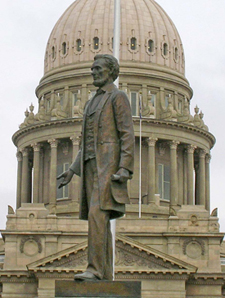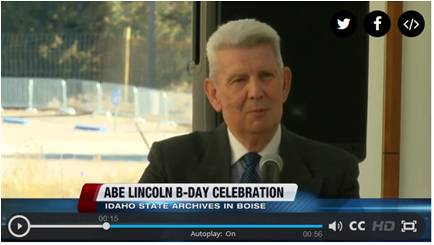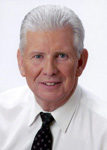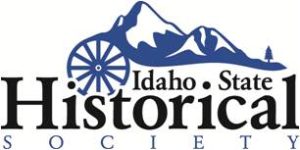by David H. Leroy, President, The Idaho Lincoln Institute and Chairman, Idaho Abraham Lincoln Bicentennial Commission
Family anecdote turned Idaho history records, as Arthur Hart wrote in “The Boiseans at Home,” that George Whitfield Russell “was especially proud of his horses, and during the 1860 Chicago presidential campaign, he had the honor of driving candidate Abraham Lincoln in a parade behind his finest clayback team.” In 1862, the family left Illinois for Oregon, eventually ending up in Boise in August of 1864. However, the Lincoln campaign connection came West too, as: “they drove the same horses that pulled Lincoln. According to Russell, they were the finest animals in the entire caravan.”
One detail in this well-told tale has apparently been misreported over the years: Between May 18, 1860, when he was nominated and the election of November 6, 1860, contemporary reports of Lincoln’s whereabouts day by day indicate that he did not participate in any parade as a presidential candidate. Instead, in the tradition of the era, Nominee Lincoln stayed home in Springfield and met delegations of supporters on his “front porch” and in his parlor.
Can the Russell story still be true? Absolutely, if one adopts the entirely likely assumption that the correct campaign parade occurred in 1858 when Lincoln ran for the Senate, not during the 1860 presidential race. In fact, still available details strengthen the likelihood that the event happened exactly as described, but two years earlier.
* George Russell is buried in Morris Hill Cemetery in Boise
* His siblings and other relatives are buried in the Russell Cemetery, near Gilson, Knox County, Illinois.
* Gilson is 6 ½ miles Southeast of Knoxville, Illinois, making it probable that George’s residence in 1858 was either in Knoxville or on an agricultural property in the surrounding area.
* On the afternoon of October 6, 1858, Lincoln arrived by train in Knoxville during a violent storm to stay at the Old Hebard House Inn. He was wearing “a big gray shawl,” a “rusty stovepipe hat” and carrying a carpetbag. That evening a crowd assembled at the hotel, a brass band serenaded Lincoln and he gave a short, humorous speech to the assemblage to the light of a lantern from the porch of the Inn.
* The next morning, Lincoln was transported by a parade of buggies, floats carrying banners and farmers in hayracks and wagons comprising a cavalculde of 1200 to 1500 persons some nine miles West to Galesburg, where the fifth Lincoln-Douglas Debate was to take place. This is likely the campaign parade in which George drove Lincoln. On arrival they paraded west along the principal street through the town to the public square, then south, then east and north. Shortly before noon, he was taken to the home of Judge Henry R. Sanderson, north of the town square. As the local Republican committee chairman, the Judge gave Lincoln an official greeting, T.G. Frost made a speech and the party’s ladies presented an embroidered campaign banner in his support.
* At two o’clock, both Lincoln and Douglas were escorted to the site of the debate at Knox College. Both candidates are reportedly transported there “in four horse carriages driven abreast.” This description is consistent with the Russell Clayback team. With up to 20,000 people in attendance, the Galesburg debate turned out to have the largest crowd of any of the 1858 Senate events. Obviously, members of the Knox County Russell family would have been among that number.
It is uncertain when or how the “presidential campaign” reference first entered the printed stories of George Russell’s pioneer history. For example, his obituary in the Idaho Daily Statesman of December 6, 1901 describes his living in Illinois between 1856 and 1862, his crossing the plains to Oregon and his removal to Boise with his family in 1864. However, no reference to his horses or the Lincoln anecdote is contained in the two columns. However, by the publication in 1914 of French’s History of Idaho, Russell’s biography therein contained the 1860 campaign story, with the additional detail that there were “four large clayback horses,” which later comprised “the finest equipped outfit” in the wagon train coming West. The inclusion of numerous other details of George’s life in the French biography make it appear likely that his children or close friends retold such anecdotes and specifics as they could recollect of the family history to French.
Since his wife had died in 1902, it is unlikely that Mary, whom George had married in 1856, was directly consulted as a source for this text. Thus, next generation individuals could have easily confused the 1858 and 1860 campaigns of half a century before, especially as the earlier unsuccessful run for the Senate would have been less well recollected by Idahoans.
The corrected reference to the 1858 campaign becomes even more likely with the additional French reported detail that George had “four clayback horses.” The contemporary description of Lincoln being driven to the Galesburg debate in a “four horse carriage” reinforces the possibility that those horses were the Russell clayback team, especially when coupled with other known details of the Know County locale, the farmer’s parade to Galesburg and the fine Illinois team that came across the prairie to Boise. Thus, the George Russell campaign story can be both validated and corrected, even at this late date.















 SPEAKER – Dave Leroy, President and Founder of the Idaho Lincoln Institute, is scheduling a limited number of speaking engagements to share Abraham Lincoln’s wisdom and how these timeless principles are important to embrace at this pivotal time in our Nation’s history. Please go to
SPEAKER – Dave Leroy, President and Founder of the Idaho Lincoln Institute, is scheduling a limited number of speaking engagements to share Abraham Lincoln’s wisdom and how these timeless principles are important to embrace at this pivotal time in our Nation’s history. Please go to 

